Leading Change: Organizational Strategy and Operations
VerifiedAdded on 2020/07/23
|13
|3929
|33
Report
AI Summary
This report examines the critical aspects of leading change within organizations, focusing on how change impacts organizational strategy and operations, as well as the influence of internal and external drivers on leadership, team, and individual behavior. The report analyzes measures to minimize the negative impacts of change, and identifies barriers to change and their influence on leadership decision-making. Furthermore, it explores the contribution of different leadership approaches in managing organizational change, using Starbucks and Costa Coffee as illustrative examples. The report delves into the application of theories like System Theory and Complexity Theory to navigate change effectively, offering insights into competitive advantage, innovation, and efficiency. It assesses both companies' marketing and pricing strategies in the context of change, and highlights how internal factors like technological capacity, employee morale, and organizational culture, along with external factors like political and economic conditions, influence business operations and leadership. The report concludes by emphasizing the importance of proactive change management policies in achieving organizational success and adapting to the evolving business environment.
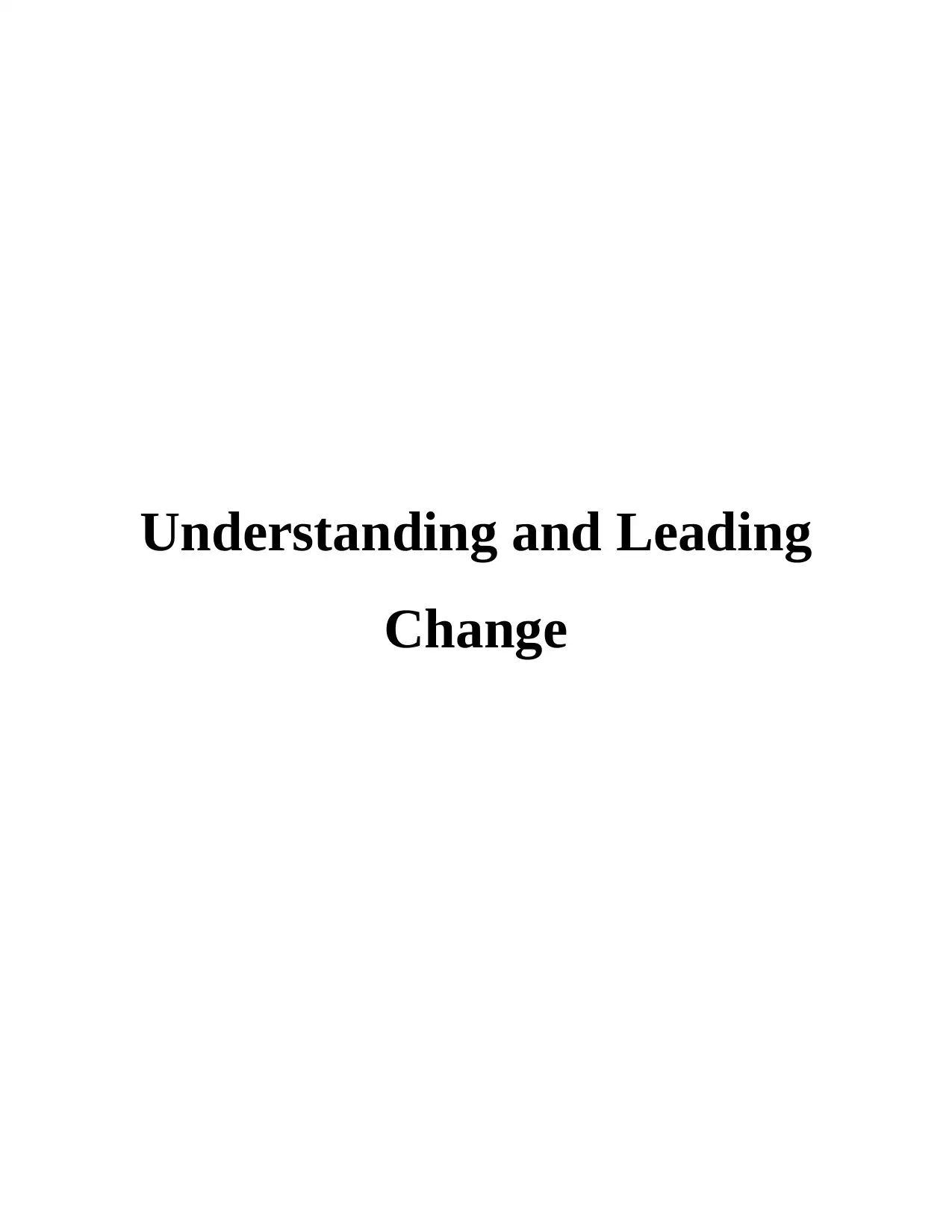
Understanding and Leading
Change
Change
Paraphrase This Document
Need a fresh take? Get an instant paraphrase of this document with our AI Paraphraser
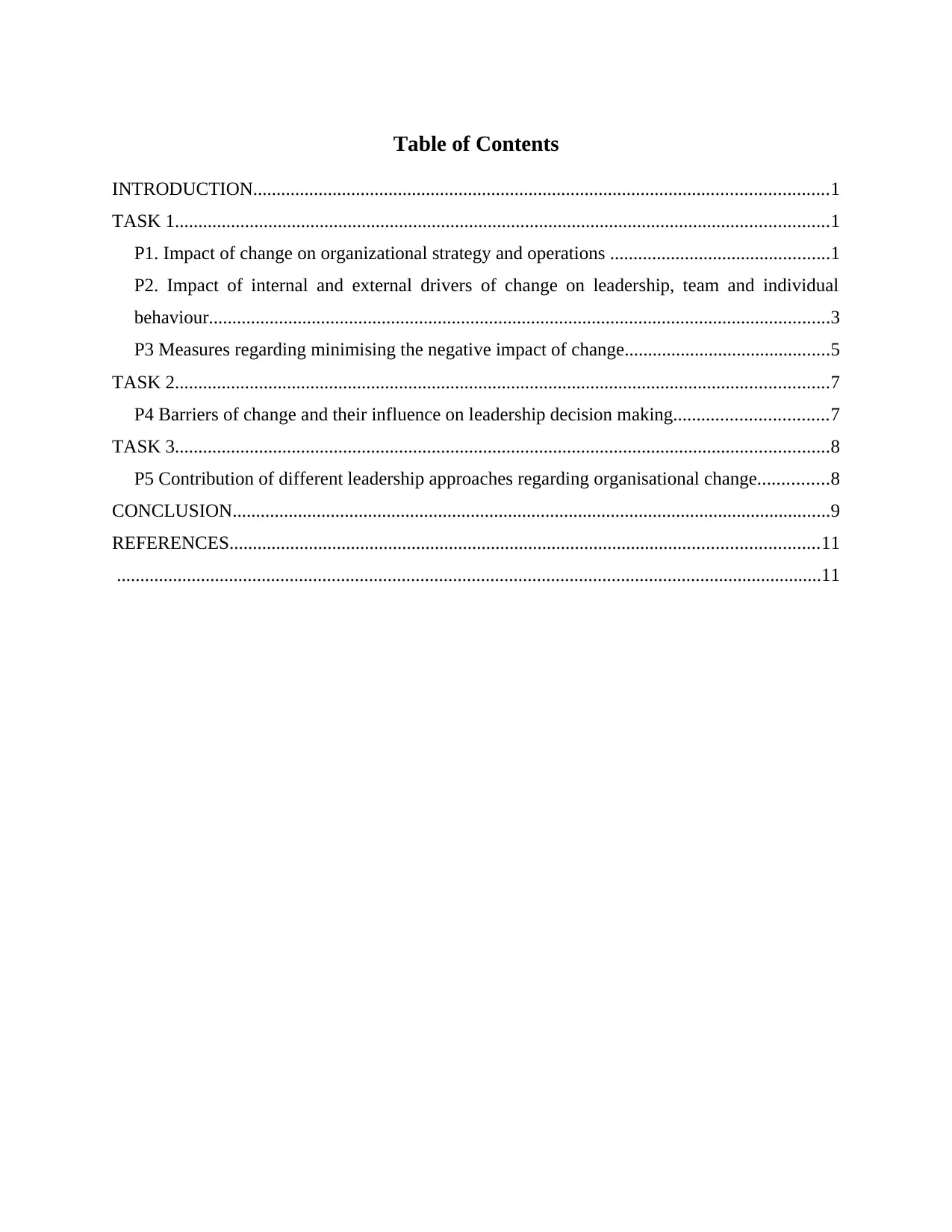
Table of Contents
INTRODUCTION...........................................................................................................................1
TASK 1............................................................................................................................................1
P1. Impact of change on organizational strategy and operations ...............................................1
P2. Impact of internal and external drivers of change on leadership, team and individual
behaviour.....................................................................................................................................3
P3 Measures regarding minimising the negative impact of change............................................5
TASK 2............................................................................................................................................7
P4 Barriers of change and their influence on leadership decision making.................................7
TASK 3............................................................................................................................................8
P5 Contribution of different leadership approaches regarding organisational change...............8
CONCLUSION................................................................................................................................9
REFERENCES..............................................................................................................................11
.......................................................................................................................................................11
INTRODUCTION...........................................................................................................................1
TASK 1............................................................................................................................................1
P1. Impact of change on organizational strategy and operations ...............................................1
P2. Impact of internal and external drivers of change on leadership, team and individual
behaviour.....................................................................................................................................3
P3 Measures regarding minimising the negative impact of change............................................5
TASK 2............................................................................................................................................7
P4 Barriers of change and their influence on leadership decision making.................................7
TASK 3............................................................................................................................................8
P5 Contribution of different leadership approaches regarding organisational change...............8
CONCLUSION................................................................................................................................9
REFERENCES..............................................................................................................................11
.......................................................................................................................................................11
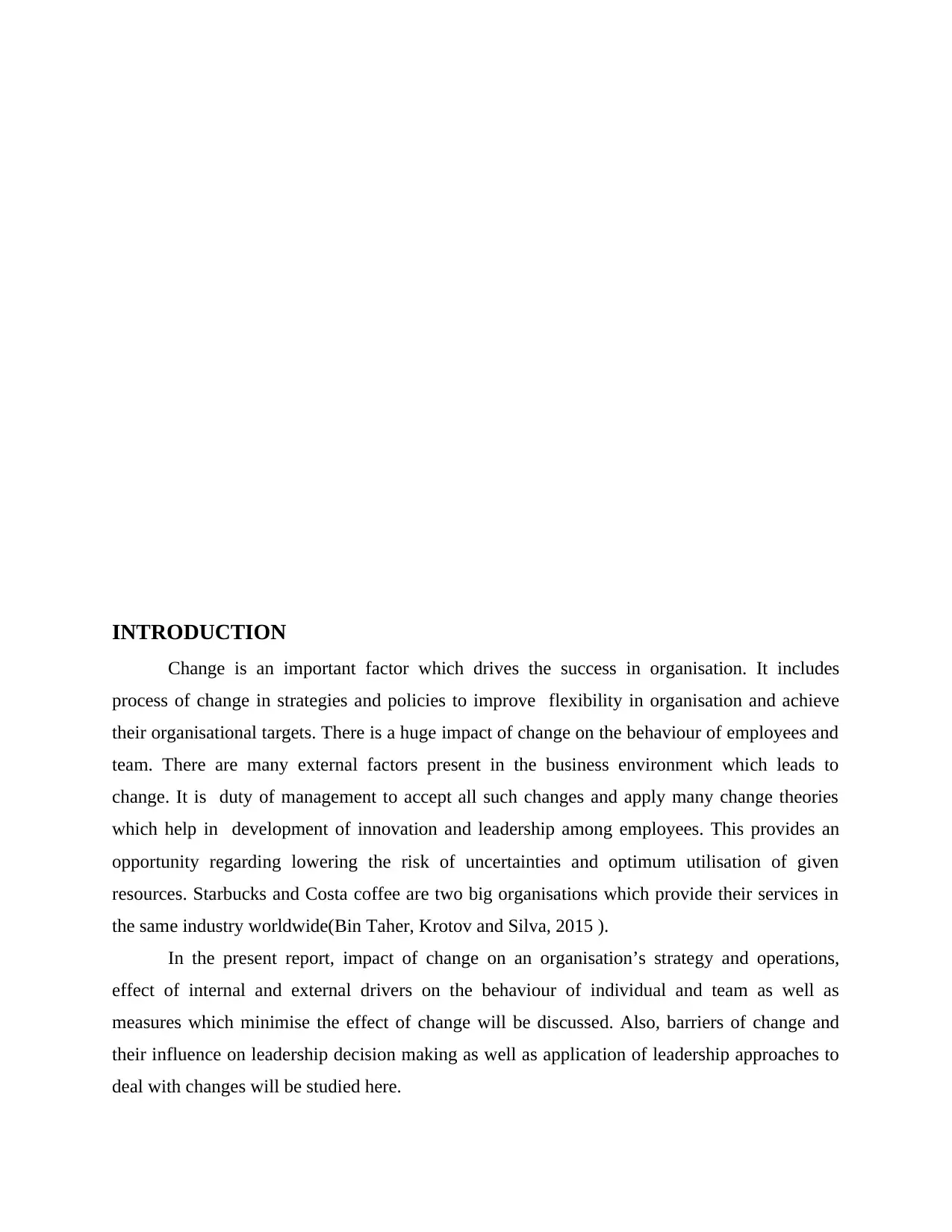
INTRODUCTION
Change is an important factor which drives the success in organisation. It includes
process of change in strategies and policies to improve flexibility in organisation and achieve
their organisational targets. There is a huge impact of change on the behaviour of employees and
team. There are many external factors present in the business environment which leads to
change. It is duty of management to accept all such changes and apply many change theories
which help in development of innovation and leadership among employees. This provides an
opportunity regarding lowering the risk of uncertainties and optimum utilisation of given
resources. Starbucks and Costa coffee are two big organisations which provide their services in
the same industry worldwide(Bin Taher, Krotov and Silva, 2015 ).
In the present report, impact of change on an organisation’s strategy and operations,
effect of internal and external drivers on the behaviour of individual and team as well as
measures which minimise the effect of change will be discussed. Also, barriers of change and
their influence on leadership decision making as well as application of leadership approaches to
deal with changes will be studied here.
Change is an important factor which drives the success in organisation. It includes
process of change in strategies and policies to improve flexibility in organisation and achieve
their organisational targets. There is a huge impact of change on the behaviour of employees and
team. There are many external factors present in the business environment which leads to
change. It is duty of management to accept all such changes and apply many change theories
which help in development of innovation and leadership among employees. This provides an
opportunity regarding lowering the risk of uncertainties and optimum utilisation of given
resources. Starbucks and Costa coffee are two big organisations which provide their services in
the same industry worldwide(Bin Taher, Krotov and Silva, 2015 ).
In the present report, impact of change on an organisation’s strategy and operations,
effect of internal and external drivers on the behaviour of individual and team as well as
measures which minimise the effect of change will be discussed. Also, barriers of change and
their influence on leadership decision making as well as application of leadership approaches to
deal with changes will be studied here.
⊘ This is a preview!⊘
Do you want full access?
Subscribe today to unlock all pages.

Trusted by 1+ million students worldwide
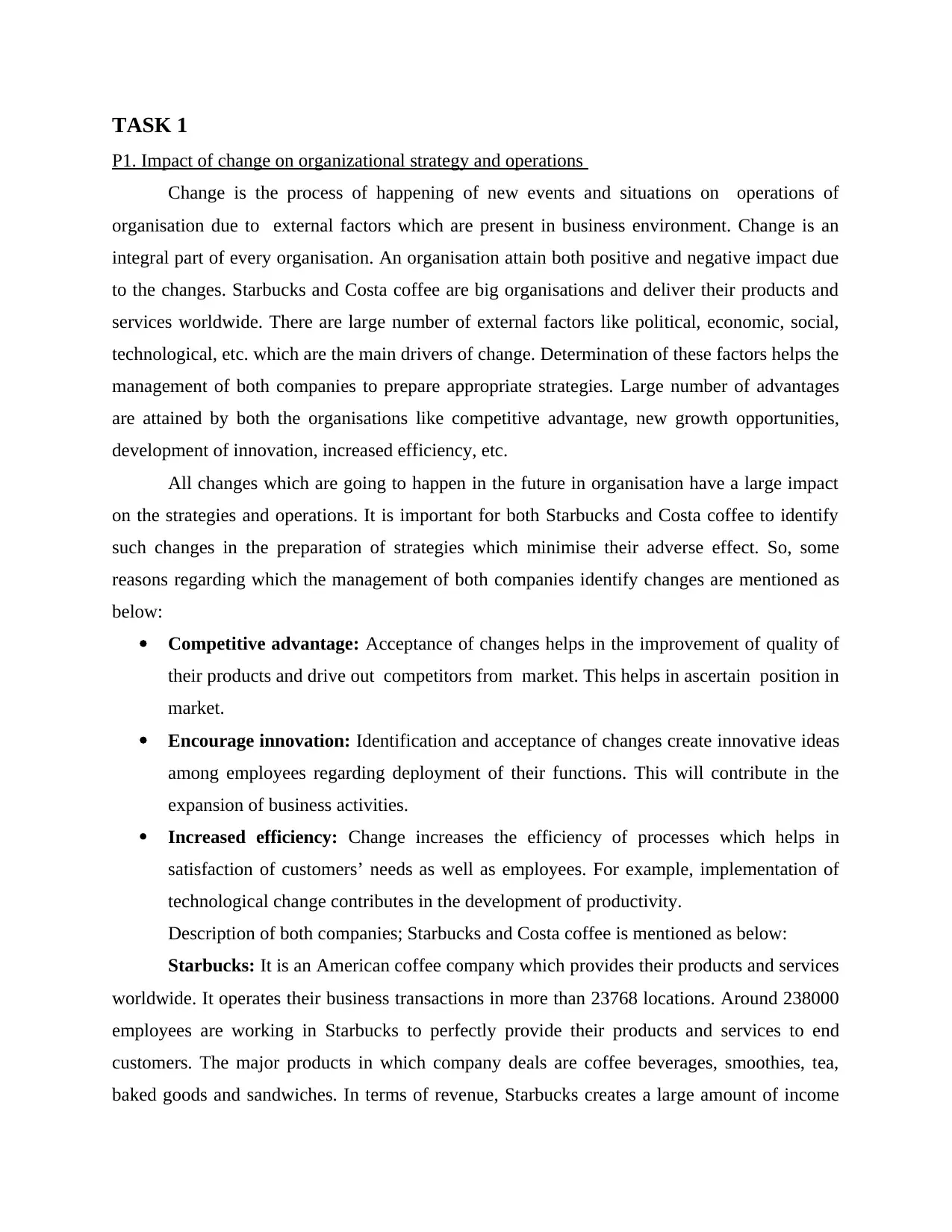
TASK 1
P1. Impact of change on organizational strategy and operations
Change is the process of happening of new events and situations on operations of
organisation due to external factors which are present in business environment. Change is an
integral part of every organisation. An organisation attain both positive and negative impact due
to the changes. Starbucks and Costa coffee are big organisations and deliver their products and
services worldwide. There are large number of external factors like political, economic, social,
technological, etc. which are the main drivers of change. Determination of these factors helps the
management of both companies to prepare appropriate strategies. Large number of advantages
are attained by both the organisations like competitive advantage, new growth opportunities,
development of innovation, increased efficiency, etc.
All changes which are going to happen in the future in organisation have a large impact
on the strategies and operations. It is important for both Starbucks and Costa coffee to identify
such changes in the preparation of strategies which minimise their adverse effect. So, some
reasons regarding which the management of both companies identify changes are mentioned as
below:
Competitive advantage: Acceptance of changes helps in the improvement of quality of
their products and drive out competitors from market. This helps in ascertain position in
market.
Encourage innovation: Identification and acceptance of changes create innovative ideas
among employees regarding deployment of their functions. This will contribute in the
expansion of business activities.
Increased efficiency: Change increases the efficiency of processes which helps in
satisfaction of customers’ needs as well as employees. For example, implementation of
technological change contributes in the development of productivity.
Description of both companies; Starbucks and Costa coffee is mentioned as below:
Starbucks: It is an American coffee company which provides their products and services
worldwide. It operates their business transactions in more than 23768 locations. Around 238000
employees are working in Starbucks to perfectly provide their products and services to end
customers. The major products in which company deals are coffee beverages, smoothies, tea,
baked goods and sandwiches. In terms of revenue, Starbucks creates a large amount of income
P1. Impact of change on organizational strategy and operations
Change is the process of happening of new events and situations on operations of
organisation due to external factors which are present in business environment. Change is an
integral part of every organisation. An organisation attain both positive and negative impact due
to the changes. Starbucks and Costa coffee are big organisations and deliver their products and
services worldwide. There are large number of external factors like political, economic, social,
technological, etc. which are the main drivers of change. Determination of these factors helps the
management of both companies to prepare appropriate strategies. Large number of advantages
are attained by both the organisations like competitive advantage, new growth opportunities,
development of innovation, increased efficiency, etc.
All changes which are going to happen in the future in organisation have a large impact
on the strategies and operations. It is important for both Starbucks and Costa coffee to identify
such changes in the preparation of strategies which minimise their adverse effect. So, some
reasons regarding which the management of both companies identify changes are mentioned as
below:
Competitive advantage: Acceptance of changes helps in the improvement of quality of
their products and drive out competitors from market. This helps in ascertain position in
market.
Encourage innovation: Identification and acceptance of changes create innovative ideas
among employees regarding deployment of their functions. This will contribute in the
expansion of business activities.
Increased efficiency: Change increases the efficiency of processes which helps in
satisfaction of customers’ needs as well as employees. For example, implementation of
technological change contributes in the development of productivity.
Description of both companies; Starbucks and Costa coffee is mentioned as below:
Starbucks: It is an American coffee company which provides their products and services
worldwide. It operates their business transactions in more than 23768 locations. Around 238000
employees are working in Starbucks to perfectly provide their products and services to end
customers. The major products in which company deals are coffee beverages, smoothies, tea,
baked goods and sandwiches. In terms of revenue, Starbucks creates a large amount of income
Paraphrase This Document
Need a fresh take? Get an instant paraphrase of this document with our AI Paraphraser
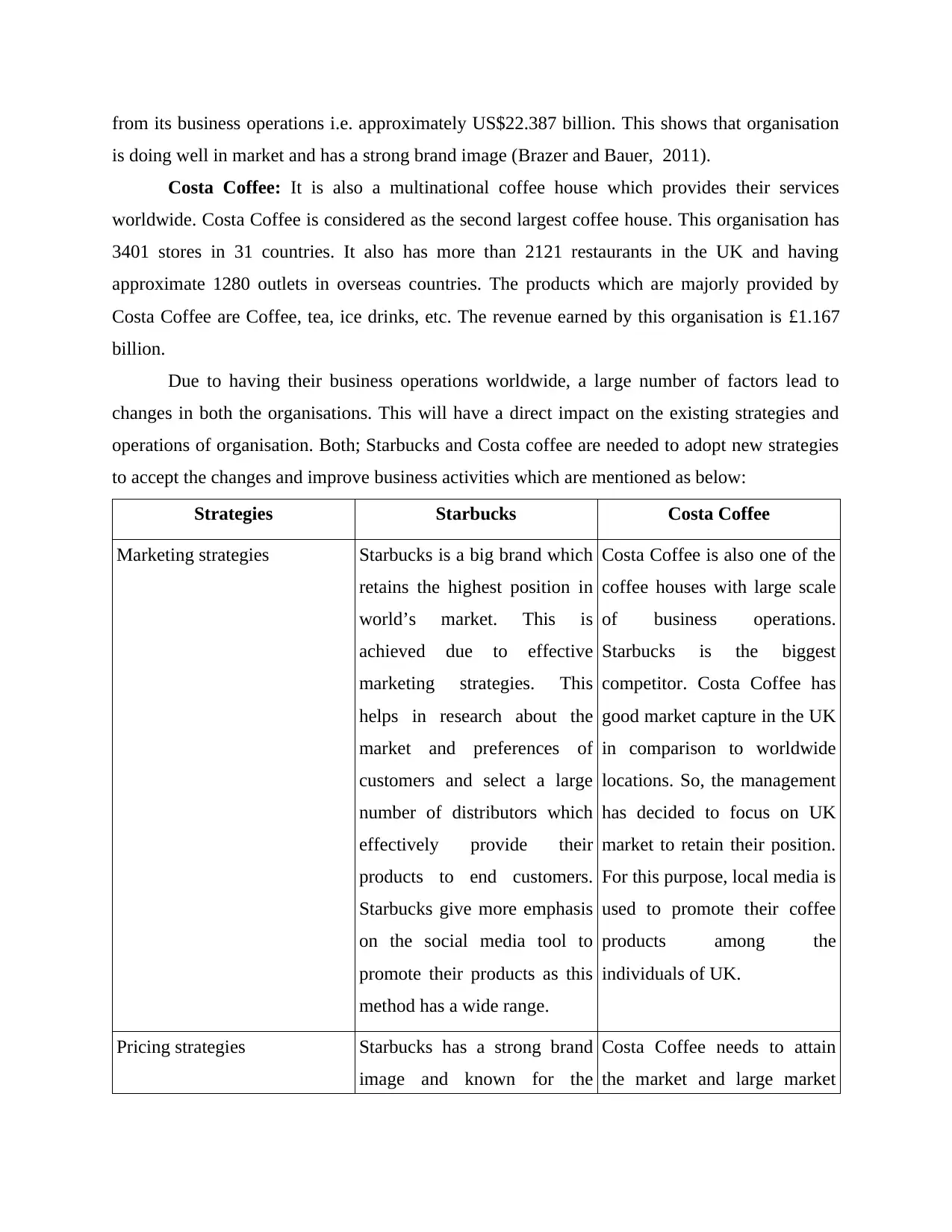
from its business operations i.e. approximately US$22.387 billion. This shows that organisation
is doing well in market and has a strong brand image (Brazer and Bauer, 2011).
Costa Coffee: It is also a multinational coffee house which provides their services
worldwide. Costa Coffee is considered as the second largest coffee house. This organisation has
3401 stores in 31 countries. It also has more than 2121 restaurants in the UK and having
approximate 1280 outlets in overseas countries. The products which are majorly provided by
Costa Coffee are Coffee, tea, ice drinks, etc. The revenue earned by this organisation is £1.167
billion.
Due to having their business operations worldwide, a large number of factors lead to
changes in both the organisations. This will have a direct impact on the existing strategies and
operations of organisation. Both; Starbucks and Costa coffee are needed to adopt new strategies
to accept the changes and improve business activities which are mentioned as below:
Strategies Starbucks Costa Coffee
Marketing strategies Starbucks is a big brand which
retains the highest position in
world’s market. This is
achieved due to effective
marketing strategies. This
helps in research about the
market and preferences of
customers and select a large
number of distributors which
effectively provide their
products to end customers.
Starbucks give more emphasis
on the social media tool to
promote their products as this
method has a wide range.
Costa Coffee is also one of the
coffee houses with large scale
of business operations.
Starbucks is the biggest
competitor. Costa Coffee has
good market capture in the UK
in comparison to worldwide
locations. So, the management
has decided to focus on UK
market to retain their position.
For this purpose, local media is
used to promote their coffee
products among the
individuals of UK.
Pricing strategies Starbucks has a strong brand
image and known for the
Costa Coffee needs to attain
the market and large market
is doing well in market and has a strong brand image (Brazer and Bauer, 2011).
Costa Coffee: It is also a multinational coffee house which provides their services
worldwide. Costa Coffee is considered as the second largest coffee house. This organisation has
3401 stores in 31 countries. It also has more than 2121 restaurants in the UK and having
approximate 1280 outlets in overseas countries. The products which are majorly provided by
Costa Coffee are Coffee, tea, ice drinks, etc. The revenue earned by this organisation is £1.167
billion.
Due to having their business operations worldwide, a large number of factors lead to
changes in both the organisations. This will have a direct impact on the existing strategies and
operations of organisation. Both; Starbucks and Costa coffee are needed to adopt new strategies
to accept the changes and improve business activities which are mentioned as below:
Strategies Starbucks Costa Coffee
Marketing strategies Starbucks is a big brand which
retains the highest position in
world’s market. This is
achieved due to effective
marketing strategies. This
helps in research about the
market and preferences of
customers and select a large
number of distributors which
effectively provide their
products to end customers.
Starbucks give more emphasis
on the social media tool to
promote their products as this
method has a wide range.
Costa Coffee is also one of the
coffee houses with large scale
of business operations.
Starbucks is the biggest
competitor. Costa Coffee has
good market capture in the UK
in comparison to worldwide
locations. So, the management
has decided to focus on UK
market to retain their position.
For this purpose, local media is
used to promote their coffee
products among the
individuals of UK.
Pricing strategies Starbucks has a strong brand
image and known for the
Costa Coffee needs to attain
the market and large market
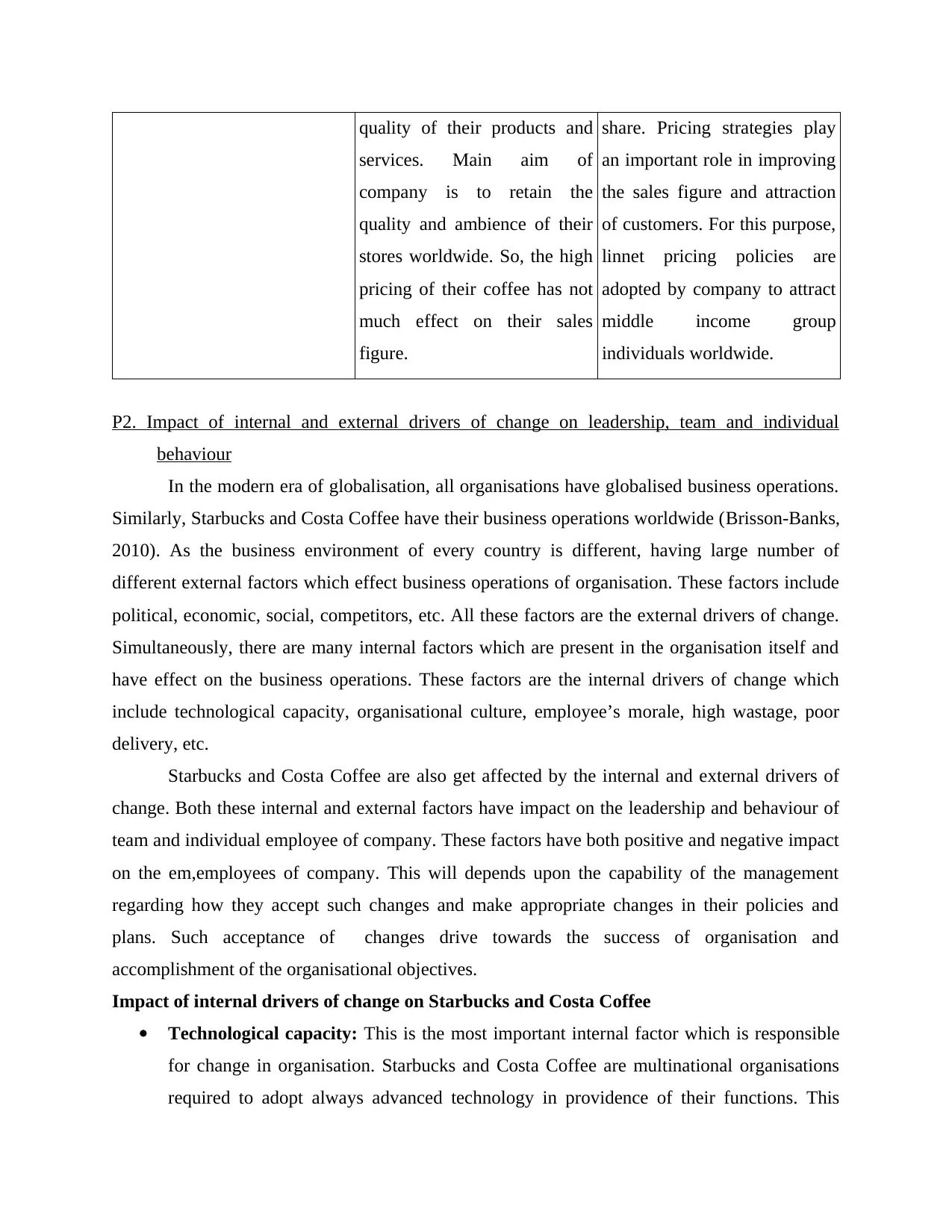
quality of their products and
services. Main aim of
company is to retain the
quality and ambience of their
stores worldwide. So, the high
pricing of their coffee has not
much effect on their sales
figure.
share. Pricing strategies play
an important role in improving
the sales figure and attraction
of customers. For this purpose,
linnet pricing policies are
adopted by company to attract
middle income group
individuals worldwide.
P2. Impact of internal and external drivers of change on leadership, team and individual
behaviour
In the modern era of globalisation, all organisations have globalised business operations.
Similarly, Starbucks and Costa Coffee have their business operations worldwide (Brisson-Banks,
2010). As the business environment of every country is different, having large number of
different external factors which effect business operations of organisation. These factors include
political, economic, social, competitors, etc. All these factors are the external drivers of change.
Simultaneously, there are many internal factors which are present in the organisation itself and
have effect on the business operations. These factors are the internal drivers of change which
include technological capacity, organisational culture, employee’s morale, high wastage, poor
delivery, etc.
Starbucks and Costa Coffee are also get affected by the internal and external drivers of
change. Both these internal and external factors have impact on the leadership and behaviour of
team and individual employee of company. These factors have both positive and negative impact
on the em,employees of company. This will depends upon the capability of the management
regarding how they accept such changes and make appropriate changes in their policies and
plans. Such acceptance of changes drive towards the success of organisation and
accomplishment of the organisational objectives.
Impact of internal drivers of change on Starbucks and Costa Coffee
Technological capacity: This is the most important internal factor which is responsible
for change in organisation. Starbucks and Costa Coffee are multinational organisations
required to adopt always advanced technology in providence of their functions. This
services. Main aim of
company is to retain the
quality and ambience of their
stores worldwide. So, the high
pricing of their coffee has not
much effect on their sales
figure.
share. Pricing strategies play
an important role in improving
the sales figure and attraction
of customers. For this purpose,
linnet pricing policies are
adopted by company to attract
middle income group
individuals worldwide.
P2. Impact of internal and external drivers of change on leadership, team and individual
behaviour
In the modern era of globalisation, all organisations have globalised business operations.
Similarly, Starbucks and Costa Coffee have their business operations worldwide (Brisson-Banks,
2010). As the business environment of every country is different, having large number of
different external factors which effect business operations of organisation. These factors include
political, economic, social, competitors, etc. All these factors are the external drivers of change.
Simultaneously, there are many internal factors which are present in the organisation itself and
have effect on the business operations. These factors are the internal drivers of change which
include technological capacity, organisational culture, employee’s morale, high wastage, poor
delivery, etc.
Starbucks and Costa Coffee are also get affected by the internal and external drivers of
change. Both these internal and external factors have impact on the leadership and behaviour of
team and individual employee of company. These factors have both positive and negative impact
on the em,employees of company. This will depends upon the capability of the management
regarding how they accept such changes and make appropriate changes in their policies and
plans. Such acceptance of changes drive towards the success of organisation and
accomplishment of the organisational objectives.
Impact of internal drivers of change on Starbucks and Costa Coffee
Technological capacity: This is the most important internal factor which is responsible
for change in organisation. Starbucks and Costa Coffee are multinational organisations
required to adopt always advanced technology in providence of their functions. This
⊘ This is a preview!⊘
Do you want full access?
Subscribe today to unlock all pages.

Trusted by 1+ million students worldwide
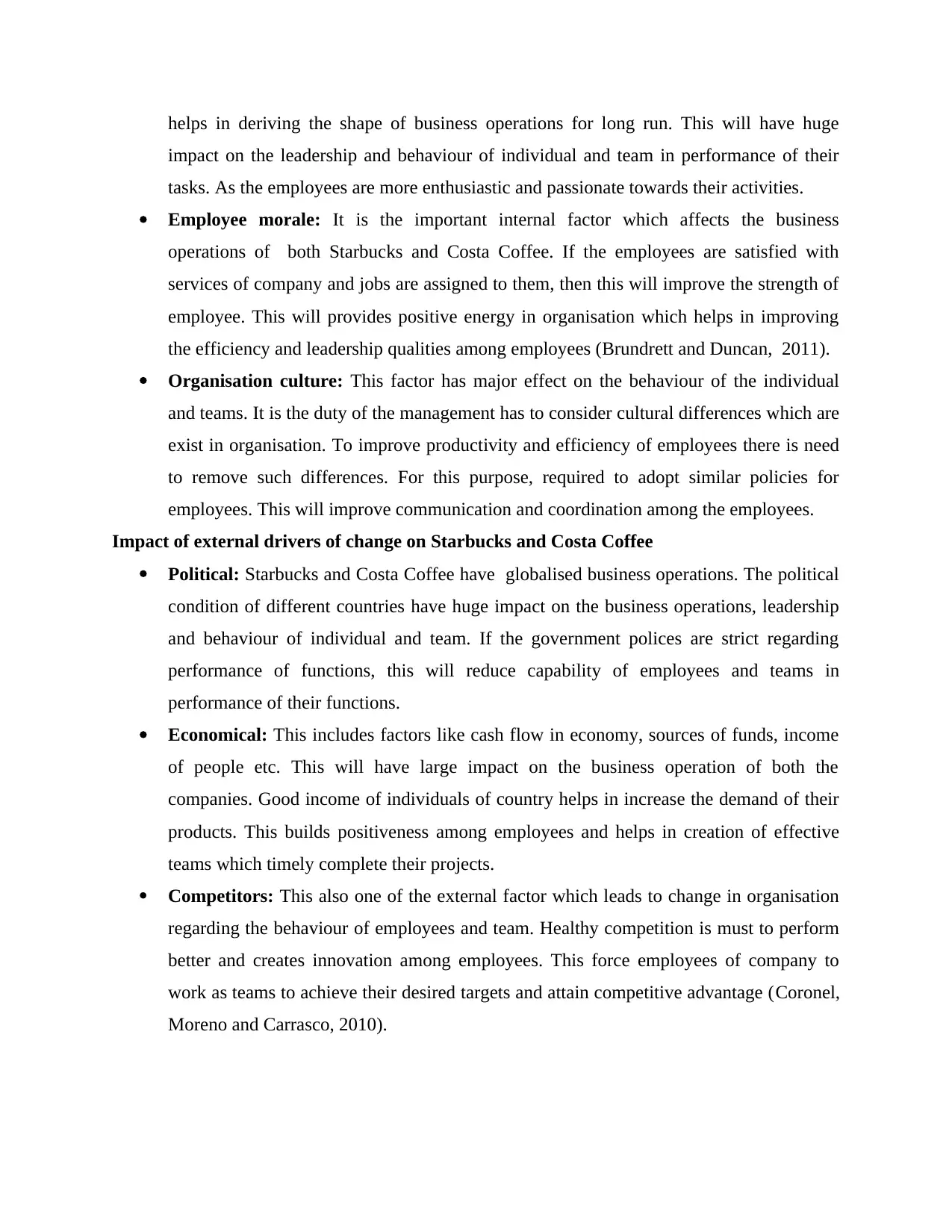
helps in deriving the shape of business operations for long run. This will have huge
impact on the leadership and behaviour of individual and team in performance of their
tasks. As the employees are more enthusiastic and passionate towards their activities.
Employee morale: It is the important internal factor which affects the business
operations of both Starbucks and Costa Coffee. If the employees are satisfied with
services of company and jobs are assigned to them, then this will improve the strength of
employee. This will provides positive energy in organisation which helps in improving
the efficiency and leadership qualities among employees (Brundrett and Duncan, 2011).
Organisation culture: This factor has major effect on the behaviour of the individual
and teams. It is the duty of the management has to consider cultural differences which are
exist in organisation. To improve productivity and efficiency of employees there is need
to remove such differences. For this purpose, required to adopt similar policies for
employees. This will improve communication and coordination among the employees.
Impact of external drivers of change on Starbucks and Costa Coffee
Political: Starbucks and Costa Coffee have globalised business operations. The political
condition of different countries have huge impact on the business operations, leadership
and behaviour of individual and team. If the government polices are strict regarding
performance of functions, this will reduce capability of employees and teams in
performance of their functions.
Economical: This includes factors like cash flow in economy, sources of funds, income
of people etc. This will have large impact on the business operation of both the
companies. Good income of individuals of country helps in increase the demand of their
products. This builds positiveness among employees and helps in creation of effective
teams which timely complete their projects.
Competitors: This also one of the external factor which leads to change in organisation
regarding the behaviour of employees and team. Healthy competition is must to perform
better and creates innovation among employees. This force employees of company to
work as teams to achieve their desired targets and attain competitive advantage (Coronel,
Moreno and Carrasco, 2010).
impact on the leadership and behaviour of individual and team in performance of their
tasks. As the employees are more enthusiastic and passionate towards their activities.
Employee morale: It is the important internal factor which affects the business
operations of both Starbucks and Costa Coffee. If the employees are satisfied with
services of company and jobs are assigned to them, then this will improve the strength of
employee. This will provides positive energy in organisation which helps in improving
the efficiency and leadership qualities among employees (Brundrett and Duncan, 2011).
Organisation culture: This factor has major effect on the behaviour of the individual
and teams. It is the duty of the management has to consider cultural differences which are
exist in organisation. To improve productivity and efficiency of employees there is need
to remove such differences. For this purpose, required to adopt similar policies for
employees. This will improve communication and coordination among the employees.
Impact of external drivers of change on Starbucks and Costa Coffee
Political: Starbucks and Costa Coffee have globalised business operations. The political
condition of different countries have huge impact on the business operations, leadership
and behaviour of individual and team. If the government polices are strict regarding
performance of functions, this will reduce capability of employees and teams in
performance of their functions.
Economical: This includes factors like cash flow in economy, sources of funds, income
of people etc. This will have large impact on the business operation of both the
companies. Good income of individuals of country helps in increase the demand of their
products. This builds positiveness among employees and helps in creation of effective
teams which timely complete their projects.
Competitors: This also one of the external factor which leads to change in organisation
regarding the behaviour of employees and team. Healthy competition is must to perform
better and creates innovation among employees. This force employees of company to
work as teams to achieve their desired targets and attain competitive advantage (Coronel,
Moreno and Carrasco, 2010).
Paraphrase This Document
Need a fresh take? Get an instant paraphrase of this document with our AI Paraphraser

P3 Measures regarding minimising the negative impact of change
A success of organisation is depends upon the change management policies which are
adopt by organisation regarding minimising the adverse effect of change on organisational
behaviour and operations. Application of such theories helps in identification of the change
which are going to happen in future and their adverse impact on employees and business plans.
There are many theories like system theory, complexity theory etc. are used by the managers of
Starbucks and Costa Coffee to minimise the negative impact of change which are mentioned
below:
System Theory: It is the effective theory which is adopt by the management of Starbucks
and Costa Coffee which helps in creation of leadership qualities among the employees.
This approach has large number of benefits in development of innovation among
employees and perfectly handle the situation of contingency. It is the effective theory
which is implemented by Starbucks in minimising the adverse effect of change. Under
this theory, leaders treat the organisation as supra system and other key factors as system.
It is the advance model which helps in minimising negative impact. The organisation for
which leader is working is known as system, teams are known as subsystem and the
leaders are assumed to be work as component system. Leaders plays the vital role in this
theory to build the qualities among the employees and make them flexible to accept the
changes.
Complexity theory: This is another important theory which is implemented by both
companies Starbucks and Costa Coffee. Application of this theory helps in measuring the
diversity present in both internal and external factors such as departments, customers,
suppliers, political, social etc. The main aim of this theory is to recognise the effect
complex situation at micro level on the capability of organisation regarding handling the
factors which are present in Macro environment. This theory has the main feature of
complex adaptive system. The function of this feature is to identifies the important
information from the environment and perfectly store such knowledge into this system.
This provides opportunity to the management regarding preparation of policies and
provide direction employees to effectively perform their function with the helps of such
plans and strategies. Such contribution of this theory helps in minimising the negative
impact of change (Ellenbogen, Berger and Batjer, 2010).
A success of organisation is depends upon the change management policies which are
adopt by organisation regarding minimising the adverse effect of change on organisational
behaviour and operations. Application of such theories helps in identification of the change
which are going to happen in future and their adverse impact on employees and business plans.
There are many theories like system theory, complexity theory etc. are used by the managers of
Starbucks and Costa Coffee to minimise the negative impact of change which are mentioned
below:
System Theory: It is the effective theory which is adopt by the management of Starbucks
and Costa Coffee which helps in creation of leadership qualities among the employees.
This approach has large number of benefits in development of innovation among
employees and perfectly handle the situation of contingency. It is the effective theory
which is implemented by Starbucks in minimising the adverse effect of change. Under
this theory, leaders treat the organisation as supra system and other key factors as system.
It is the advance model which helps in minimising negative impact. The organisation for
which leader is working is known as system, teams are known as subsystem and the
leaders are assumed to be work as component system. Leaders plays the vital role in this
theory to build the qualities among the employees and make them flexible to accept the
changes.
Complexity theory: This is another important theory which is implemented by both
companies Starbucks and Costa Coffee. Application of this theory helps in measuring the
diversity present in both internal and external factors such as departments, customers,
suppliers, political, social etc. The main aim of this theory is to recognise the effect
complex situation at micro level on the capability of organisation regarding handling the
factors which are present in Macro environment. This theory has the main feature of
complex adaptive system. The function of this feature is to identifies the important
information from the environment and perfectly store such knowledge into this system.
This provides opportunity to the management regarding preparation of policies and
provide direction employees to effectively perform their function with the helps of such
plans and strategies. Such contribution of this theory helps in minimising the negative
impact of change (Ellenbogen, Berger and Batjer, 2010).
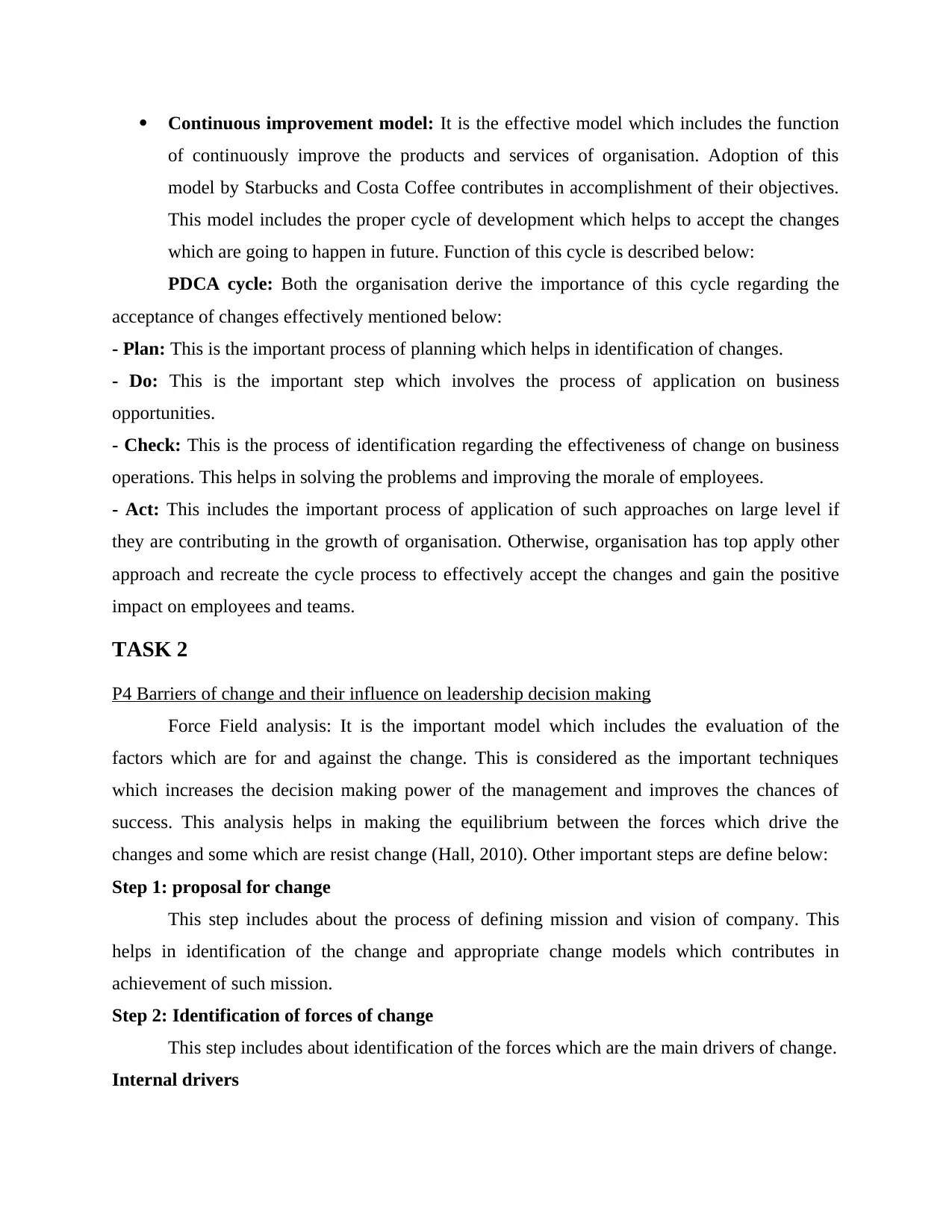
Continuous improvement model: It is the effective model which includes the function
of continuously improve the products and services of organisation. Adoption of this
model by Starbucks and Costa Coffee contributes in accomplishment of their objectives.
This model includes the proper cycle of development which helps to accept the changes
which are going to happen in future. Function of this cycle is described below:
PDCA cycle: Both the organisation derive the importance of this cycle regarding the
acceptance of changes effectively mentioned below:
- Plan: This is the important process of planning which helps in identification of changes.
- Do: This is the important step which involves the process of application on business
opportunities.
- Check: This is the process of identification regarding the effectiveness of change on business
operations. This helps in solving the problems and improving the morale of employees.
- Act: This includes the important process of application of such approaches on large level if
they are contributing in the growth of organisation. Otherwise, organisation has top apply other
approach and recreate the cycle process to effectively accept the changes and gain the positive
impact on employees and teams.
TASK 2
P4 Barriers of change and their influence on leadership decision making
Force Field analysis: It is the important model which includes the evaluation of the
factors which are for and against the change. This is considered as the important techniques
which increases the decision making power of the management and improves the chances of
success. This analysis helps in making the equilibrium between the forces which drive the
changes and some which are resist change (Hall, 2010). Other important steps are define below:
Step 1: proposal for change
This step includes about the process of defining mission and vision of company. This
helps in identification of the change and appropriate change models which contributes in
achievement of such mission.
Step 2: Identification of forces of change
This step includes about identification of the forces which are the main drivers of change.
Internal drivers
of continuously improve the products and services of organisation. Adoption of this
model by Starbucks and Costa Coffee contributes in accomplishment of their objectives.
This model includes the proper cycle of development which helps to accept the changes
which are going to happen in future. Function of this cycle is described below:
PDCA cycle: Both the organisation derive the importance of this cycle regarding the
acceptance of changes effectively mentioned below:
- Plan: This is the important process of planning which helps in identification of changes.
- Do: This is the important step which involves the process of application on business
opportunities.
- Check: This is the process of identification regarding the effectiveness of change on business
operations. This helps in solving the problems and improving the morale of employees.
- Act: This includes the important process of application of such approaches on large level if
they are contributing in the growth of organisation. Otherwise, organisation has top apply other
approach and recreate the cycle process to effectively accept the changes and gain the positive
impact on employees and teams.
TASK 2
P4 Barriers of change and their influence on leadership decision making
Force Field analysis: It is the important model which includes the evaluation of the
factors which are for and against the change. This is considered as the important techniques
which increases the decision making power of the management and improves the chances of
success. This analysis helps in making the equilibrium between the forces which drive the
changes and some which are resist change (Hall, 2010). Other important steps are define below:
Step 1: proposal for change
This step includes about the process of defining mission and vision of company. This
helps in identification of the change and appropriate change models which contributes in
achievement of such mission.
Step 2: Identification of forces of change
This step includes about identification of the forces which are the main drivers of change.
Internal drivers
⊘ This is a preview!⊘
Do you want full access?
Subscribe today to unlock all pages.

Trusted by 1+ million students worldwide
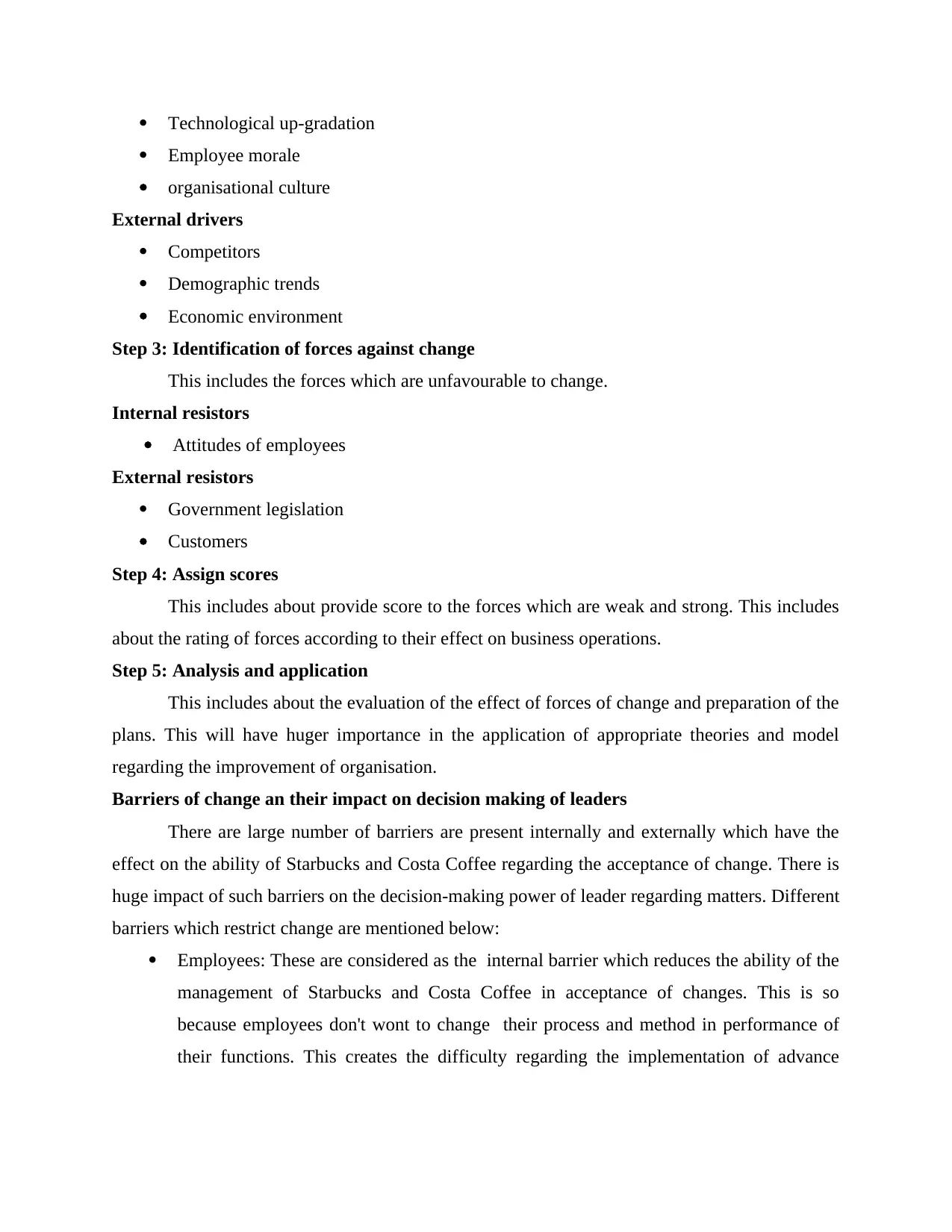
Technological up-gradation
Employee morale
organisational culture
External drivers
Competitors
Demographic trends
Economic environment
Step 3: Identification of forces against change
This includes the forces which are unfavourable to change.
Internal resistors
Attitudes of employees
External resistors
Government legislation
Customers
Step 4: Assign scores
This includes about provide score to the forces which are weak and strong. This includes
about the rating of forces according to their effect on business operations.
Step 5: Analysis and application
This includes about the evaluation of the effect of forces of change and preparation of the
plans. This will have huger importance in the application of appropriate theories and model
regarding the improvement of organisation.
Barriers of change an their impact on decision making of leaders
There are large number of barriers are present internally and externally which have the
effect on the ability of Starbucks and Costa Coffee regarding the acceptance of change. There is
huge impact of such barriers on the decision-making power of leader regarding matters. Different
barriers which restrict change are mentioned below:
Employees: These are considered as the internal barrier which reduces the ability of the
management of Starbucks and Costa Coffee in acceptance of changes. This is so
because employees don't wont to change their process and method in performance of
their functions. This creates the difficulty regarding the implementation of advance
Employee morale
organisational culture
External drivers
Competitors
Demographic trends
Economic environment
Step 3: Identification of forces against change
This includes the forces which are unfavourable to change.
Internal resistors
Attitudes of employees
External resistors
Government legislation
Customers
Step 4: Assign scores
This includes about provide score to the forces which are weak and strong. This includes
about the rating of forces according to their effect on business operations.
Step 5: Analysis and application
This includes about the evaluation of the effect of forces of change and preparation of the
plans. This will have huger importance in the application of appropriate theories and model
regarding the improvement of organisation.
Barriers of change an their impact on decision making of leaders
There are large number of barriers are present internally and externally which have the
effect on the ability of Starbucks and Costa Coffee regarding the acceptance of change. There is
huge impact of such barriers on the decision-making power of leader regarding matters. Different
barriers which restrict change are mentioned below:
Employees: These are considered as the internal barrier which reduces the ability of the
management of Starbucks and Costa Coffee in acceptance of changes. This is so
because employees don't wont to change their process and method in performance of
their functions. This creates the difficulty regarding the implementation of advance
Paraphrase This Document
Need a fresh take? Get an instant paraphrase of this document with our AI Paraphraser
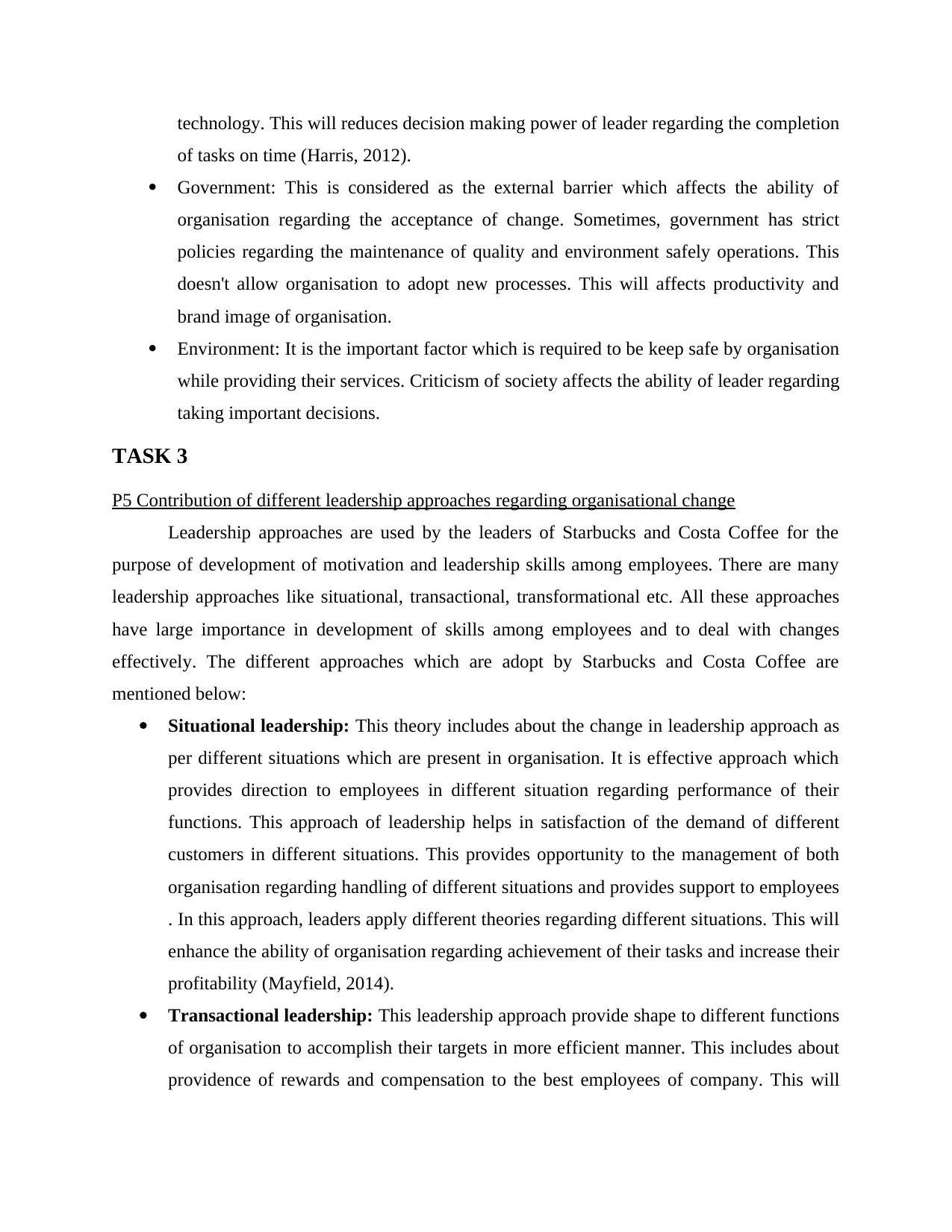
technology. This will reduces decision making power of leader regarding the completion
of tasks on time (Harris, 2012).
Government: This is considered as the external barrier which affects the ability of
organisation regarding the acceptance of change. Sometimes, government has strict
policies regarding the maintenance of quality and environment safely operations. This
doesn't allow organisation to adopt new processes. This will affects productivity and
brand image of organisation.
Environment: It is the important factor which is required to be keep safe by organisation
while providing their services. Criticism of society affects the ability of leader regarding
taking important decisions.
TASK 3
P5 Contribution of different leadership approaches regarding organisational change
Leadership approaches are used by the leaders of Starbucks and Costa Coffee for the
purpose of development of motivation and leadership skills among employees. There are many
leadership approaches like situational, transactional, transformational etc. All these approaches
have large importance in development of skills among employees and to deal with changes
effectively. The different approaches which are adopt by Starbucks and Costa Coffee are
mentioned below:
Situational leadership: This theory includes about the change in leadership approach as
per different situations which are present in organisation. It is effective approach which
provides direction to employees in different situation regarding performance of their
functions. This approach of leadership helps in satisfaction of the demand of different
customers in different situations. This provides opportunity to the management of both
organisation regarding handling of different situations and provides support to employees
. In this approach, leaders apply different theories regarding different situations. This will
enhance the ability of organisation regarding achievement of their tasks and increase their
profitability (Mayfield, 2014).
Transactional leadership: This leadership approach provide shape to different functions
of organisation to accomplish their targets in more efficient manner. This includes about
providence of rewards and compensation to the best employees of company. This will
of tasks on time (Harris, 2012).
Government: This is considered as the external barrier which affects the ability of
organisation regarding the acceptance of change. Sometimes, government has strict
policies regarding the maintenance of quality and environment safely operations. This
doesn't allow organisation to adopt new processes. This will affects productivity and
brand image of organisation.
Environment: It is the important factor which is required to be keep safe by organisation
while providing their services. Criticism of society affects the ability of leader regarding
taking important decisions.
TASK 3
P5 Contribution of different leadership approaches regarding organisational change
Leadership approaches are used by the leaders of Starbucks and Costa Coffee for the
purpose of development of motivation and leadership skills among employees. There are many
leadership approaches like situational, transactional, transformational etc. All these approaches
have large importance in development of skills among employees and to deal with changes
effectively. The different approaches which are adopt by Starbucks and Costa Coffee are
mentioned below:
Situational leadership: This theory includes about the change in leadership approach as
per different situations which are present in organisation. It is effective approach which
provides direction to employees in different situation regarding performance of their
functions. This approach of leadership helps in satisfaction of the demand of different
customers in different situations. This provides opportunity to the management of both
organisation regarding handling of different situations and provides support to employees
. In this approach, leaders apply different theories regarding different situations. This will
enhance the ability of organisation regarding achievement of their tasks and increase their
profitability (Mayfield, 2014).
Transactional leadership: This leadership approach provide shape to different functions
of organisation to accomplish their targets in more efficient manner. This includes about
providence of rewards and compensation to the best employees of company. This will
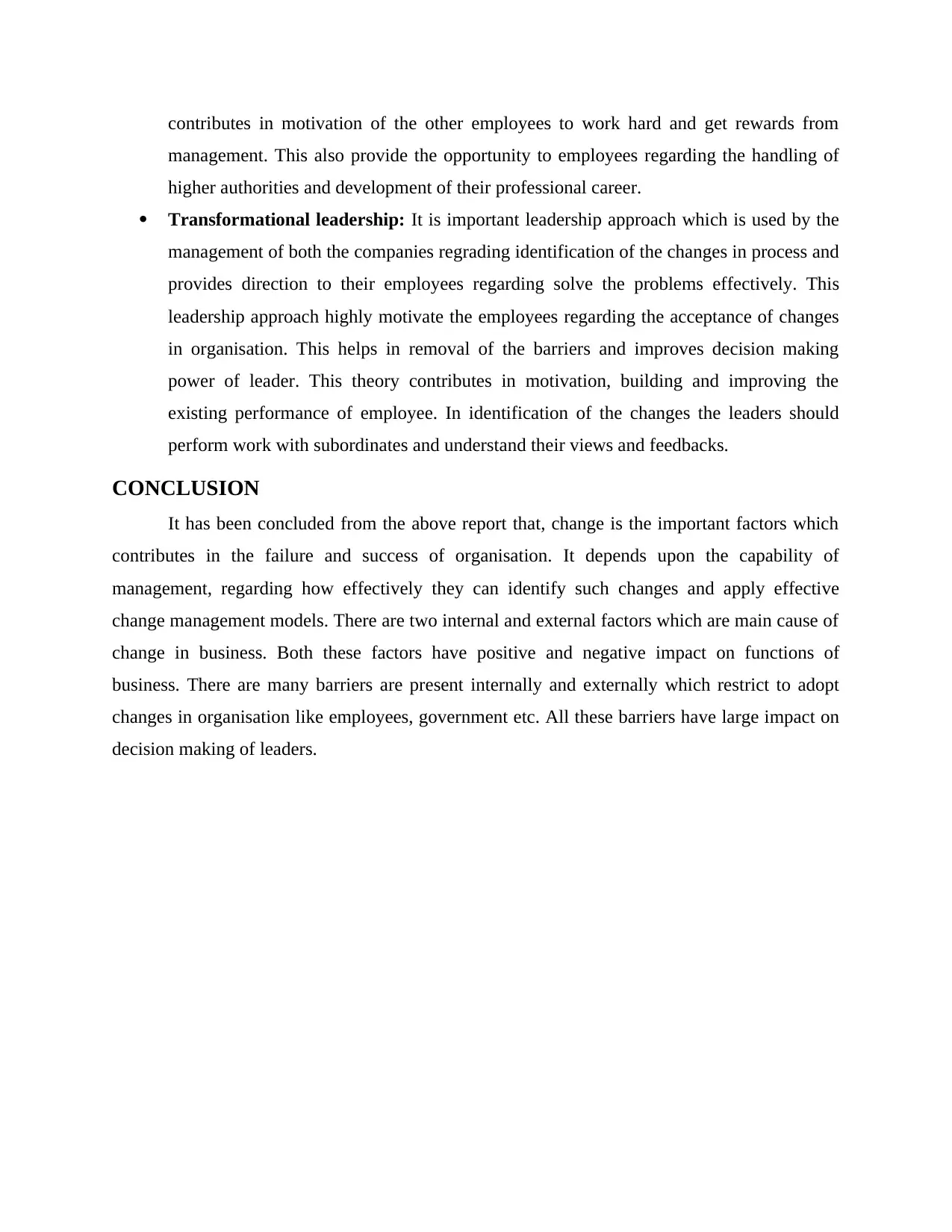
contributes in motivation of the other employees to work hard and get rewards from
management. This also provide the opportunity to employees regarding the handling of
higher authorities and development of their professional career.
Transformational leadership: It is important leadership approach which is used by the
management of both the companies regrading identification of the changes in process and
provides direction to their employees regarding solve the problems effectively. This
leadership approach highly motivate the employees regarding the acceptance of changes
in organisation. This helps in removal of the barriers and improves decision making
power of leader. This theory contributes in motivation, building and improving the
existing performance of employee. In identification of the changes the leaders should
perform work with subordinates and understand their views and feedbacks.
CONCLUSION
It has been concluded from the above report that, change is the important factors which
contributes in the failure and success of organisation. It depends upon the capability of
management, regarding how effectively they can identify such changes and apply effective
change management models. There are two internal and external factors which are main cause of
change in business. Both these factors have positive and negative impact on functions of
business. There are many barriers are present internally and externally which restrict to adopt
changes in organisation like employees, government etc. All these barriers have large impact on
decision making of leaders.
management. This also provide the opportunity to employees regarding the handling of
higher authorities and development of their professional career.
Transformational leadership: It is important leadership approach which is used by the
management of both the companies regrading identification of the changes in process and
provides direction to their employees regarding solve the problems effectively. This
leadership approach highly motivate the employees regarding the acceptance of changes
in organisation. This helps in removal of the barriers and improves decision making
power of leader. This theory contributes in motivation, building and improving the
existing performance of employee. In identification of the changes the leaders should
perform work with subordinates and understand their views and feedbacks.
CONCLUSION
It has been concluded from the above report that, change is the important factors which
contributes in the failure and success of organisation. It depends upon the capability of
management, regarding how effectively they can identify such changes and apply effective
change management models. There are two internal and external factors which are main cause of
change in business. Both these factors have positive and negative impact on functions of
business. There are many barriers are present internally and externally which restrict to adopt
changes in organisation like employees, government etc. All these barriers have large impact on
decision making of leaders.
⊘ This is a preview!⊘
Do you want full access?
Subscribe today to unlock all pages.

Trusted by 1+ million students worldwide
1 out of 13
Related Documents
Your All-in-One AI-Powered Toolkit for Academic Success.
+13062052269
info@desklib.com
Available 24*7 on WhatsApp / Email
![[object Object]](/_next/static/media/star-bottom.7253800d.svg)
Unlock your academic potential
Copyright © 2020–2025 A2Z Services. All Rights Reserved. Developed and managed by ZUCOL.





